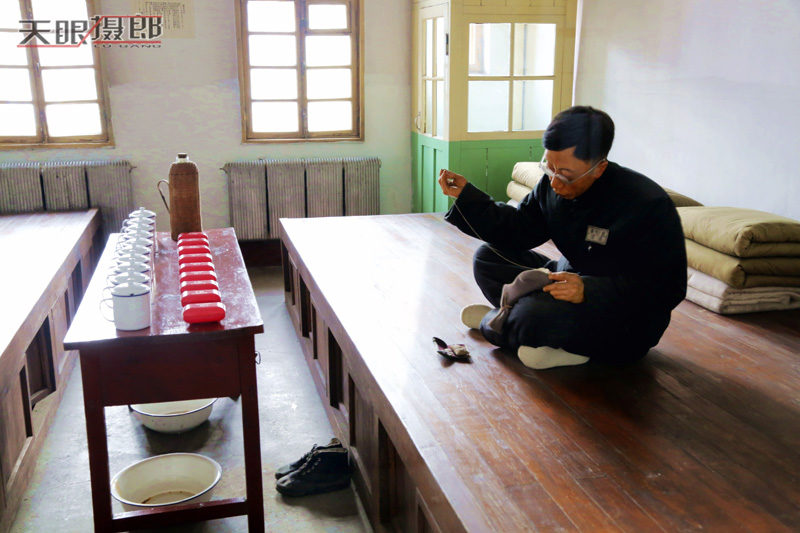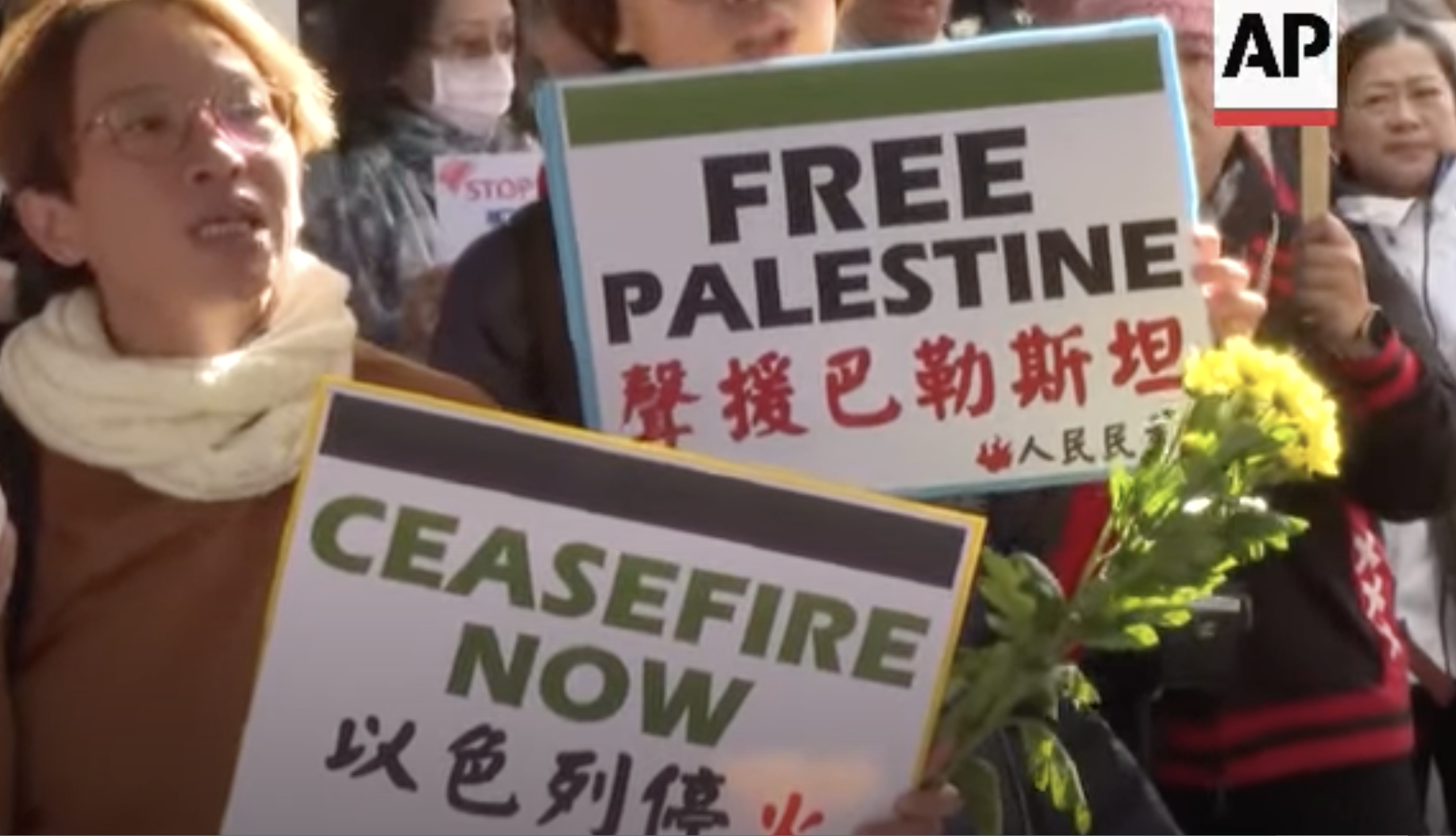
Diorama depicting the incarceration of Puyi (溥儀), the last emperor of China, at Liaodong No. 3 Prison (Fushun) in Harbin. Photo by Xinhua News Agency contract photographer Lu Gang.
The Ichinomiya Teacher's Association, via a joint Twitter account run by staffers at an Association office in a small city in the suburbs of Nagoya, has been posting some interesting tweets from the city of Harbin, in northeastern China.
A staffer with the association vacationing in northeastern China has captured Japanese colonial architecture and other reminders of the long war Japan waged against China in the 1930s and 1940s.
Some of the most striking snapshots posted to the feed are from the prison known as the Fushun War Criminals Management Center.
The prison in Fushun held about 1,000 former Japanese administrators of Manchuko, the puppet state established with Japanese backing in northeastern China in 1932.
Puyi (溥儀), the last emperor of China, was installed by Japan as the constitutional monarch of Manchuko from 1932 to 1945 and was incarcerated in the Fushun prison along with Japanese administrators and military commanders considered to be war criminals.
労働する溥儀。 pic.twitter.com/ZDw6T3vv9l
— 一宮市教組 公式 (@138shikyoso) August 11, 2016
Puyi at work.
While some commentators say Japanese war criminals incarcerated at Fushun were “brainwashed” by the Chinese Communist Party, oral testimony by the prisoners themselves stressed the focus was on rehabilitation and admitting to the crimes against humanity committed by Japanese forces during the long war against China, that began with the invasion of Manchuria in 1931 and continued until Japan's defeat in 1945.
The tweets by the Ichinomiya Teacher's Association account capture some of this sentiment.
撫順戦犯管理所での日本人戦犯の様子。この絵も元戦犯が描いたもの。 pic.twitter.com/1o51OY5Gel
— 一宮市教組 公式 (@138shikyoso) August 11, 2016
Japanese war criminals held at Liaodong No. 3 Prison (Fushun) following WWII. Painting by Japanese POW.
During their tour of northeastern China, the person in charge of the Ichinomiya Teacher's Association's Twitter account observed there is still much evidence of Japan's wartime conduct in northeastern China.
平頂山事件の現場。在瀋陽日本国総領事も献花に訪れたことがあります。つまり、日本政府もこの事実を認めています。 pic.twitter.com/JtOCzmz6Kt
— 一宮市教組 公式 (@138shikyoso) August 11, 2016
Where the Pingdingshan massacre happened. There is a wreath here from the Japanese Consulate in Shenyang, and the Japanese government has officially acknowledged this (atrocity) took place.
While the museum at Fushun undoubtedly serves a political agenda, the exhibits are moving and do humanize a cohort of individuals typically referred to as “Japanese war criminals.”
寛大な判決文を読み、涙を流す武部六蔵。死刑は一人もいませんでした。 pic.twitter.com/W46ojUFDwM
— 一宮市教組 公式 (@138shikyoso) August 11, 2016
Top Manchuko colonial civil servant Takebe Rokuzo weeps as he reads the (war crimes tribunal's) judgement against him. No war criminals (at Fushun) were given the death penalty.
The staffer from the Ichinomiya Teacher's Association also witnessed the scene of one of the more infamous crimes committed by Japan during the war in China.
Unit 731 is the name of the facility in northeastern China where Japanese forces conducted gruesome medical experiments on Chinese prisoners.
731部隊跡。 pic.twitter.com/7ygeHSNzlM
— 一宮市教組 公式 (@138shikyoso) August 10, 2016
The ruins of Unit 731.
Other tweets provide a glimpse back not only to the time when Japan managed Manchuko as a colony, but also to a period of strong Russian influence in northeastern China.
Here are some snapshots of Saint Sophia's Cathedral in Harbin, completed in 1932, when about one-third of Harbin's population consisted of ethnic Russians:
聖ソフィア聖堂。 pic.twitter.com/r6vW3aTSx6
— 一宮市教組 公式 (@138shikyoso) August 12, 2016
Saint Sophia's Cathedral
The region also has strong ties to the Korean Peninsula:
平壌館。 pic.twitter.com/2WLcLhvL8j
— 一宮市教組 公式 (@138shikyoso) August 11, 2016
Pyongyang Pavilion restaurant, Harbin
Next up is Shenyang, the largest city in northeastern China.
The city was known as Mukden during the Japanese colonial era and was the major commercial and industrial hub in Manchuko. Many buildings from the colonial period remain.
旧東洋拓殖株式会社奉天支社。 pic.twitter.com/ZbjAGgD6uz
— 一宮市教組 公式 (@138shikyoso) August 11, 2016
Former Shenyang branch of the Oriental Development Company.
旧朝鮮銀行奉天支店。 pic.twitter.com/vBqavX1O2Q
— 一宮市教組 公式 (@138shikyoso) August 11, 2016
Former Shenyang branch of the Bank of Korea.
旧奉天警察署。 pic.twitter.com/G9IbCEYPAO
— 一宮市教組 公式 (@138shikyoso) August 11, 2016
Former Shenyang police headquarters (of the Japanese colonial administration).
旧奉天大和ホテル。 pic.twitter.com/jQyM86SB4Z
— 一宮市教組 公式 (@138shikyoso) August 11, 2016
Former Shenyang Yamato Hotel.
正確には分かりませんが、かつての日本人住宅? pic.twitter.com/r3esgwpTzO
— 一宮市教組 公式 (@138shikyoso) August 11, 2016
Hard to confirm, but could these be the residences of former Japanese colonists?
旧奉天郵便局。約100年前の建物。 pic.twitter.com/VVH4eHhpPg
— 一宮市教組 公式 (@138shikyoso) August 11, 2016
Former Shenyang Post Office. Built approximately 100 years ago.
The tour and the tweets wrap up in Qingdao, across the Bohai Sea to the southwest of Shengyeng and Harbin.
A former German colony before being claimed by Japan, Qingdao is famous for its Munich-style lager:
青島ビール。 pic.twitter.com/Jgr10Ath5k
— 一宮市教組 公式 (@138shikyoso) August 13, 2016







2 comments
The brick building shown is more likely housing for administrators than colonists. The colonists as such were mostly rural and up near the border area with the Soviet Union.
I have had a number of Chinese students from what was Manshu. They generally have positive feelings about the Japanese coupled to a sense that the region has been getting the short end of the stick under Chinese state capitalism.
Harbin has pushed aggressively for Japanese investment and encouraged Japanese language education.
I’ve long wanted to tour Manchuria. I believe it is the key to understanding events of the 1930s-1940s in Japan. The state capitalist model the military imposed in Manchuria was the inspiration for many patterns seen in Japan from the 1940s well into the 1990s.
Hi Earl, I only just saw this article for some reason. I hope you’re doing well. I do see your articles in Japan Forward from time to time. Very thought-provoking, and forces me to challenge my assumptions (so I can continue to disagree with you, lol).